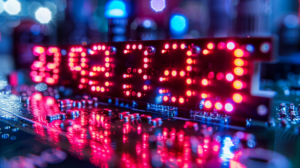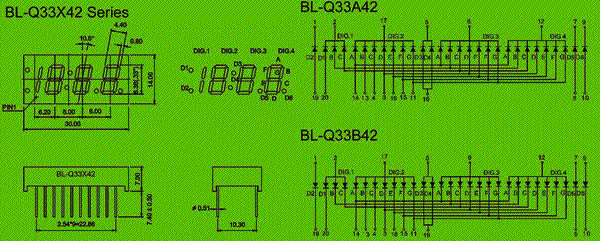0.33 inch 4-digit seven segment led display | Ultra Amber
Related Article List
Article No | color | material | wavelength | apperance | v_typ | v_max | luminous_min | luminous_typ | degree |
|---|---|---|---|---|---|---|---|---|---|
Ultra Blue |
InGaN |
470 |
4.2 |
120 |
|||||
Super Red |
GaAlAs/GaAs,DH |
660 |
2.2 |
110 |
|||||
Orange |
GaAsP/GaP |
635 |
2.5 |
105 |
|||||
Green |
GaP/GaP |
570 |
2.5 |
110 |
|||||
Ultra Pure Green |
InGaN |
525 |
4.2 |
195 |
|||||
Hi Red |
GaAlAs/GaAs,SH |
660 |
2.2 |
100 |
|||||
Ultra Orange |
AlGaInP |
630 |
2.5 |
130 |
|||||
Ultra Green |
AlGaInP |
574 |
2.5 |
130 |
|||||
Ultra Red |
AlGaInP |
645 |
2.5 |
150 |
|||||
Ultra Red |
GaAlAs/GaAs,DDH |
660 |
2.2 |
150 |
|||||
Ultra Yellow |
AlGaInP |
590 |
2.5 |
120 |
|||||
Ultra White |
InGaN |
- |
4.2 |
140 |
|||||
Yellow |
GaAsP/GaP |
585 |
2.5 |
105 |
|||||
Ultra Amber |
AlGaInP |
619 |
2.5 |
130 |
Product Series information
Product Series |
|---|
 Series No:BL-Q33A-42 Dimension 30 × 14 × 7 mm Description: ___________________________________________________________________________________________________________________________________________________ IntroductionIn the fast-paced world of electronics manufacturing, the 0.33 inch 4-digit seven segment LED display stands out as a crucial component for a wide range of applications. Known for its efficiency and reliability, the common cathode seven segment configuration is particularly favored for its simplicity and ease of integration into complex circuits. This article delves into the features, applications, benefits, and real-world effectiveness of these displays, backed by case studies and testimonials from industry professionals.Key Features of the 0.33 Inch 4-Digit Seven Segment LED DisplayThe 0.33 inch 4-digit seven segment LED display is renowned for its compact design and high visibility. Each segment consists of a single LED, making it ideal for displaying numbers and a few letters, which is sufficient for most electronic devices requiring a simple, clear output interface.High Visibility and Low Power ConsumptionThese displays are designed to be energy efficient, drawing minimal power which is a critical consideration in portable and battery-operated devices. The LED technology ensures that the display is bright and easily readable even from a distance and in low-light conditions.Common Cathode Seven Segment ConfigurationThe common cathode seven segment setup means that all the cathodes of the LEDs are connected to a common ground. This configuration allows for simpler control logic and reduced power usage, as only a single connection to the negative voltage is needed for all segments.Applications Across IndustriesFrom consumer electronics to industrial applications, the versatility of the 0.33 inch 4-digit seven segment LED display is evident. Common applications include:
Benefits for Manufacturers and End-UsersElectronics manufacturers appreciate the ease of use and cost-effectiveness of integrating these displays into their products. End-users benefit from the reliability and clarity of the information presented, enhancing the overall user experience.Cost-Effectiveness and Ease of IntegrationThe simplicity of the common cathode design not only reduces initial costs but also lowers ongoing maintenance expenses due to the longevity and durability of LED technology.Real-World Case Studies and User TestimonialsCase Study: Integration in Home AppliancesA leading appliance manufacturer recently integrated these displays into a range of kitchen appliances, enhancing usability and customer satisfaction. The displays provided clear, immediate feedback on settings and timers, crucial for effective operation. Testimonial from Jane Doe, Appliance Design Engineer: "We chose the 0.33 inch 4-digit seven segment LED display for its reliability and clarity. Our customers appreciate the intuitive interface that enhances their daily interactions with our products."Case Study: Automotive ApplicationsAn automotive company used these LED displays for dashboard instruments, providing drivers with clear and immediate feedback on vehicle performance. Testimonial from John Smith, Automotive Engineer: "The common cathode seven segment displays were perfect for our dashboards, offering brightness and accuracy essential for vehicle safety."ConclusionThe 0.33 inch 4-digit seven segment LED display is a testament to the advancements in LED technology and its applications in modern electronics. Its benefits are clearly demonstrated in its widespread use, proving that even small components can make a significant impact on the functionality and user-friendliness of electronic devices. Features
Applications
___________________________________________________________________________________________________________________________________________________ Dimension and Circuit Drawing:  |
Related Information
Soldering
When soldering, leave a minimum of 2mm clearance from the base of the base of the lens to the soldering point. Dipping the lens into the solder must be avoided.
Do not apply any external stress to the lead frame during soldering while the LED is at high temperature.
Recommended soldering conditions:
| IR Reflow Soldering (for SMD display) | Wave Soldering | Soldering Iron | |||
| Pre-Heat | 150-180°C | Pre-Heat | 100°C Max. | Temperature | 300°C Max. |
| Pre-Heat Time | 120sec Max. | Pre-Heat Time | 60sec Max. | ||
| Peak Temperature | 260°C Max. | SolderWave | 260°C Max. | Soldering Time | 3sec Max.(one time only) |
| Soldering Time | 10 sec Max. | Soldering Time | 5sec Max. | ||
Note: Excessive soldering temperature and/or time might result in deformation of the LED lens or failure of the LED
ESD(Electrostatic Discharge)
Static Electricity or power surge will damage the LED.
Suggestions to prevent ESD (Electrostatic Discharge):
n Use a conductive wrist band or anti-electrostatic glove when handling these LEDs
n All devices, equipment, and machinery must be properly grounded
n Work tables, storage racks, etc. should be properly grounded
n Use ion blower to neutralize the static charge which might have built up on surface of the LED’s
plastic lens as a result of friction between LEDs during storage and handling
ESD-damaged LEDs will exhibit abnormal characteristics such as high reverse leakage current,
low forward voltage, or “no light on” at low currents. To verify for ESD damage, check for “light on”
and Vf of the suspect LEDs at low currents.
The Vf of “good” LEDs should be>2.0V@0.1mA for InGaN product and >1.4V@0.1mA for AlInGaP
product.

When selecting power for LED systems, it’s essential to understand several key parameters to ensure safe operation, longevity, and optimal performance. Here are some steps and considerations for LED power selection:
- Determine the Forward Voltage (Vf) of the LED(s):
Each LED has a forward voltage, which is the voltage at which the LED operates when the current is flowing through it. This value can typically be found in the LED’s datasheet.
- Determine the Forward Current (If) of the LED(s):
The forward current is the current at which the LED is designed to operate. Running an LED at higher than its rated current can reduce its lifespan and increase the heat it produces.
- Decide on the Configuration:
Series Configuration: When LEDs are connected in series, the forward voltages add up, but the current remains the same.
Parallel Configuration: When LEDs are connected in parallel, the forward voltage remains the same, but the currents add up. This configuration can be risky because if one LED fails or has a slightly lower forward voltage, it can cause the other LEDs to draw more current.
Calculate Total Power Requirements:
Power (W) = Total Forward Voltage (V) x Total Forward Current (A)
For example, if you have three LEDs connected in series, each with a forward voltage of 3V and a forward current of 20mA, the total power requirement would be:
Power = (3V + 3V + 3V) x 20mA = 9V x 0.02A = 0.18W
- Select an Appropriate Power Supply:
- Voltage Rating: The power supply voltage should match or slightly exceed the total forward voltage of your LED configuration.
- Current Rating: The power supply’s current rating should meet or exceed the total forward current of your LED configuration.
- Safety Margin: It’s a good practice to select a power supply that can provide at least 20% more power than your calculated requirement. This ensures the power supply isn’t operating at its maximum capacity, which can extend its life and ensure safer operation.
- Consider Additional Features:
- Dimming Capability: If you want to control the brightness of your LEDs, choose a power supply with dimming capabilities.
- Overcurrent and Overvoltage Protection: To protect your LEDs, select a power supply with built-in protection mechanisms.
- Thermal Management: Ensure that the power supply has adequate cooling, especially if it will be enclosed or in a location with limited airflow.
- Regulation and Efficiency:A power supply with good regulation will maintain a consistent voltage output despite variations in the load. High efficiency ensures minimal power is wasted as heat.
- Physical Size and Form Factor:Depending on where you plan to place the power supply, its size and shape may be critical factors.
In summary, when selecting power for LED systems, understanding your LED’s requirements and the configuration you plan to use is essential. Then, pick a power supply that meets those needs with some added safety margin, keeping in mind any additional features or constraints relevant to your project.
Here are some well-regarded brands in the industry:
- Mean Well: One of the most recognized brands in the LED power supply industry, Mean Well offers a wide range of products suitable for both indoor and outdoor applications. Their units often come with features like overcurrent protection, dimming capabilities, and high efficiency.
- Tridonic: A global leader in lighting technology, Tridonic offers LED drivers and power supplies that cater to various lighting solutions, from simple setups to advanced smart lighting systems.
- Philips Advance Xitanium: Philips is a well-known brand in the lighting industry, and their Xitanium series of LED drivers are known for reliability and performance. They cater to both indoor and outdoor LED applications.
- Osram: Another giant in the lighting industry, Osram offers a range of LED drivers and power supplies suitable for various applications, including architectural and street lighting.
- LIFUD: Specializing in LED drivers, LIFUD is known for its high-quality products that cater to both commercial and residential LED lighting solutions.
- MOSO: This brand offers a variety of LED drivers, especially for outdoor and industrial applications. Their products are known for durability and performance.
- TDK-Lambda: With a history in power electronics, TDK-Lambda offers a range of power supplies and LED drivers suitable for various applications, emphasizing reliability and advanced features.



